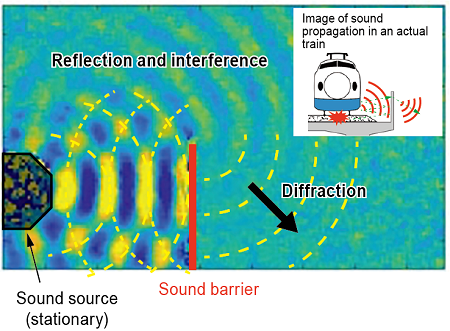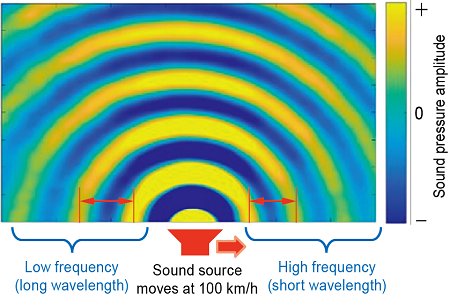26. Method of visualizing sound wave propagation for clarification and prediction of railway noise
Railway noise is characterized by the fact that sound sources move at high speed and by the presence of reflective objects such as vehicle bodies and sound barriers around the sound sources. So, to understand and predict this phenomenon, it is important to grasp the propagation of sound. We therefore developed a method for visualizing the propagation of sound emitted from a moving source through the air and the diffraction behavior of sound waves near a sound barrier.
To visualize sound waves, we used a parallel phase-shifting interferometer (Fig. 1). This device captures images of the interference fringes of laser light with a high-speed camera, making use of the fact that pressure fluctuations in the air caused by sound can be observed as phase changes in the light. We also developed a method for estimating the sound pressure distribution within a specific cross-section based on the theoretical equations for spherical waves.
By applying this method to a 1:80-scale model of a noise barrier, we confirmed that it is possible to visualize the reflection, interference, and diffraction attenuation of sound waves observed around the noise barrier (Fig. 2). Using a model launcher system to visualize the wave fronts of sound emitted from a moving sound source—a model train fitted with an ultrasonic transducer—we confirmed the ability to observe frequency modulation due to the Doppler effect (Fig. 3). This is the first time that the Doppler effect has been experimentally visualized in the air. With this method, we expect to be able to validate a physical model of multiple reflections between vehicle bodies and sound barriers and to evaluate the reflection, interference, and diffraction of sound waves under realistic railway structures. All this will be useful in further improving the accuracy of noise prediction methods along railway lines.
Other Contents
- 22. Earthquake early detection method based on deep learning of seismic motion
- 23. HILS for the current collection systems using a High-Speed Test Facility for Pantograph/OCL Systems
- 24. Mechanism of increasing wear rate of contact wires near pantograph stopping positions of Shinkansen
- 25. Text analysis codes for human error analysis
- 26. Method of visualizing sound wave propagation for clarification and prediction of railway noise
- 22. Earthquake early detection method based on deep learning of seismic motion
- 23. HILS for the current collection systems using a High-Speed Test Facility for Pantograph/OCL Systems
- 24. Mechanism of increasing wear rate of contact wires near pantograph stopping positions of Shinkansen
- 25. Text analysis codes for human error analysis
- 26. Method of visualizing sound wave propagation for clarification and prediction of railway noise



